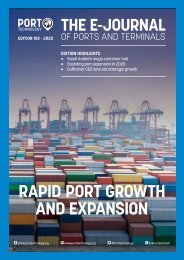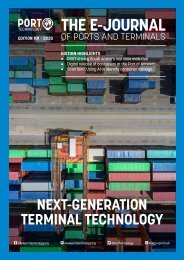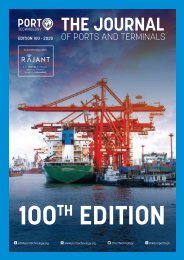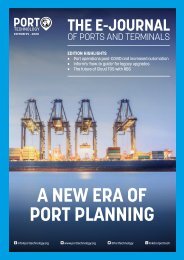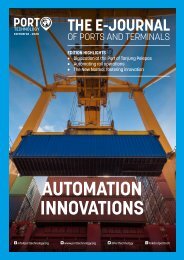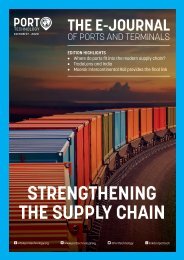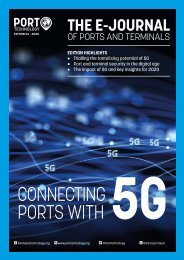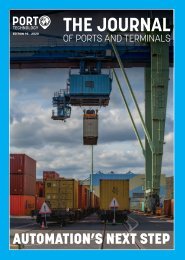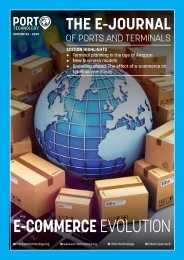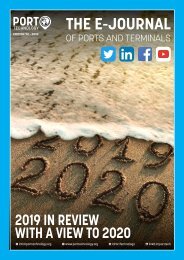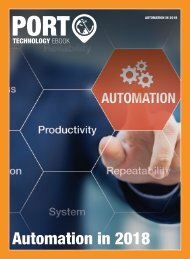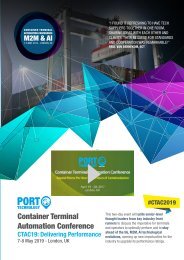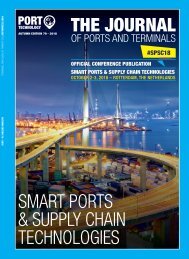A Sustainable Future
Port Technology International’s first e-Journal of 2020 explores the topic of sustainability in ports. Climate change is set to be a defining topic for the 2020s as awareness of its real-time impact is increasing.
Port Technology International’s first e-Journal of 2020 explores the topic of sustainability in ports. Climate change is set to be a defining topic for the 2020s as awareness of its real-time impact is increasing.
Create successful ePaper yourself
Turn your PDF publications into a flip-book with our unique Google optimized e-Paper software.
PORT<br />
TECHNOLOGY<br />
EDITION 93 - 2020<br />
THE E-JOURNAL<br />
OF PORTS AND TERMINALS<br />
EDITION HIGHLIGHTS<br />
• Increasing terminal capacity<br />
• Pathways to zero emissions<br />
• Dealing with the effects of climate change<br />
A SUSTAINABLE FUTURE<br />
8 info@porttechnology.org X www.porttechnology.org T @PortTechnology l linkd.in/porttech
5G, MACHINE LEARNING & EXPONENTIAL TECH<br />
FROM THE<br />
EDITOR<br />
One topic that will define the 2020s is climate change. Already<br />
this year we have seen the wealthiest people on the planet<br />
descend on Davos, S witzerland, to discuss climate change and<br />
the risks it poses for the global economy.<br />
The World Economic Forum has, for the first time, included<br />
climate change in the ‘ top five risks by likelihood’ in its Global<br />
R isk R eport.<br />
But what does that mean for the maritime industry, in<br />
particular ports? Global shipping is often cited as one of the<br />
worst industries for pollution, alongside aviation, however a<br />
concerted effort is being made by regulatory bodies to reduce<br />
harmful emissions produced by ships.<br />
The much anticipated International Maritime Organisation’ s<br />
(IMO) regulations to reduce sulphur emissions came into<br />
effect on 1 J anuary 2020.<br />
Papers in this journal examine the new regulations and<br />
what may happen next, including asking if the IMO’ s initiative<br />
is enough.<br />
Throughout 2020 it is likely we will continue to see a<br />
strong focus on the IMO’ s sulphur regulations as the industry<br />
looks to comply and cut emissions across the maritime<br />
supply chain.<br />
Ports themselves also have many challenges around the<br />
issue of climate change and sustainability. The Port of Oakland<br />
outlines its path to becoming a net zero-emissions port and<br />
how it plans to achieve this.<br />
Meanwhile, the Fundación Valenciaport, an initiative of<br />
the Port Authority of Valencia considers how climate change<br />
affects ports, with extreme weather events having impact on<br />
operations, and how to deal with these changes.<br />
Finally, ABB Ports presents a special case study on how<br />
to increase the capacity of the terminal yard. This study<br />
investigates the way Tianjin Five Continents International<br />
Container Terminal Co. Ltd. (FICT) in China resolved the ‘ megaage’<br />
yard challenge. This includes a high level of automation<br />
being adopted by the port.<br />
Beth Maundrill<br />
Editor<br />
CONTENTS<br />
2 THE PORT OF OAKLAND’S PATHWAY TO ZERO EMISSIONS<br />
Dianne Heinze, Environmental S upervisor, Port of Oakland<br />
4 INCREASING TERMINAL CAPACITY BY 10%: A CASE STUDY IN YARD TRANSFORMATION<br />
Bjö rn Henriksson, ABB Ports, S weden and Lin Hong-Wei and Wang Hong-Liang, Tianjin Port Container Terminal Co., Ltd<br />
9 DEVELOPING A PORT SUSTAINABILITY INDEX<br />
Isabela Brown, The Earth Institute, Columbia U niversity<br />
12 HOW TO DEAL WITH THE EFFECTS OF CLIMATE CHANGE IN PORTS?<br />
Noemí Monterde, Project Manager, Fundación Valenciaport<br />
15 WHY WILL IMO 2020 SAVE FEWER LIVES THAN EXPECTED?<br />
Pablo R odas-Martini, Author of the Book “ IMO 2020: A R egulatory Tsunami”<br />
8 info@ porttechnology.org X www.porttechnology.org<br />
T @ PortTechnology l linkd.in/ porttech<br />
1 EDITION 85<br />
WWW.PORTTECHNOLOGY.ORG
A SUSTAINABLE FUTURE<br />
THE PORT OF OAKLAND’S<br />
PATHWAY TO<br />
ZERO EMISSIONS<br />
Diane Heinze, Environmental Supervisor, Port of Oakland<br />
The Port of Oakland strives for the<br />
cleanest operations to support the right to<br />
clean air for its workers and neighboring<br />
community. In June 2019, the Board of Port<br />
Commissioners approved the “ S eaport<br />
Air Quality 2020 and Beyond Plan: The<br />
Pathway to Zero Emissions” (Plan) to<br />
minimize diesel particulate matter and<br />
greenhouse gas emissions. The Port is a<br />
landlord port and does not own or operate<br />
equipment including trucks, cargo handling<br />
equipment, ships or locomotives.<br />
As the property owner and a public<br />
agency, the Port functions as a liaison with<br />
Port tenants (and associated equipment<br />
owners and operators), the West Oakland<br />
community and air quality regulators. To<br />
implement the Plan, Port staff evaluate the<br />
feasibility of zero and near zero-emissions<br />
equipment and encourage equipment<br />
owners to operate the cleanest equipment.<br />
The feasibility criteria in the Plan include<br />
commercial availability, operational<br />
feasibility, cost, community exposure<br />
reduction, cost-effectiveness, acceptability<br />
and need.<br />
This article summarizes efforts to<br />
minimize four major mobile source<br />
categories: cargo handling equipment,<br />
drayage trucks, tugs and ships.<br />
CARGO HANDLING EQUIPMENT (CHE) AND<br />
DRAYAGE TRUCKS<br />
Zero emissions CHE and drayage trucks<br />
have been a focus in California especially<br />
since the Ports of Los Angeles and Long<br />
Beach announced their joint goals of all<br />
zero-emissions CHE by 2030, and all zero<br />
emissions drayage trucks by 2035. While<br />
applauding the San Pedro Bay ports for<br />
establishing these goals at the nation’s<br />
largest seaport, the approach in Oakland is<br />
to establish goals based on the feasibility<br />
criteria in the Plan. The Port recently<br />
conducted two feasibility studies focused<br />
on CHE and drayage trucks as discussed<br />
below.<br />
CHE: The feasibility study concludes that<br />
zero-emissions yard tractors operating in<br />
ancillary support areas (outside marine<br />
terminals or off-dock) meet the Port’s<br />
feasibility criteria. Battery electric yard<br />
tractors are commercially available<br />
(vendors include OrangeEV, BD and<br />
almar); they are operationally feasible,<br />
and they are affordable with State of<br />
California incentive funding. The best<br />
source of incentive funding is the California<br />
Air Resources Board’s (CARB) voucher<br />
program which can fund up to 150,000<br />
for the tractor, 30,000 for electric<br />
infrastructure, plus another 10% because<br />
the seaport is adjacent to a disadvantaged<br />
community. To date, six OrangeEV yard<br />
tractors are operating off dock at the<br />
seaport.<br />
2 EDITION 93<br />
WWW.PORTTECHNOLOGY.ORG
A SUSTAINABLE FUTURE<br />
However, zero-emissions yard tractors<br />
are not yet operationally feasible at<br />
marine terminals. Terminal operators<br />
need tractors that can pull two loaded<br />
20-foot containers on a chassis (or “bomb<br />
cart” - a chassis where import containers<br />
from vessels are dropped) for one or more<br />
shis. Another issue at marine terminals<br />
is the desire for inductive versus manual<br />
charging of battery electric equipment.<br />
Another type of CHE determined to<br />
be feasible is hybrid rubber tired gantry<br />
(RTG) cranes. RTG cranes are used to stack<br />
and load import containers onto drayage<br />
trucks. Currently, all 13 RTG cranes<br />
at Oakland’s largest marine terminal,<br />
Oakland International Container Terminal<br />
(OICT), are being retrofitted using Mi-<br />
Jack Products hybrid electric technology.<br />
In Oakland, RTG cranes are used to<br />
stack imports in the yard and then load<br />
them onto drayage trucks. The terminal<br />
operator reports that diesel consumption<br />
has reduced from 10-12 gallonshour to<br />
1.2 gallonshour.<br />
Drayage Trucks: Over 5,000 drayage<br />
trucks transport containers to and<br />
from Oakland’s four marine terminals.<br />
Currently, two off dock tenants operate a<br />
total of seven battery electric BD drayage<br />
trucks which have all been funded by<br />
CARB. Currently, the retail cost of a new<br />
battery-electric drayage truck is unknown,<br />
but it is likely several 100,000’s more<br />
than a used diesel drayage truck (which<br />
is what independent owner-operators<br />
typically buy). Another consideration is<br />
that currently, battery-electric drayage<br />
trucks are only commercially available for<br />
sale by one manufacturer.<br />
The Port, in collaboration with the Port<br />
of Long Beach and others received a Zero<br />
and Near Zero Freight Facilities (ZANZEFF)<br />
grant from CARB to install electric<br />
infrastructure and operate ten zeroemissions<br />
PeterbiltTranspower drayage<br />
trucks at a tenant facility. The estimated<br />
cost for these trucks is about 500,000<br />
each, plus 200,000 each for Transpower’s<br />
proprietary charging units. Construction of<br />
the infrastructure costs approximately 1<br />
million with construction commencing in<br />
spring 2020.<br />
Community Exposure from CHE and<br />
Drayage Trucks: As part of the West<br />
Oakland Community Action Plan recently<br />
approved by CARB, the local air district<br />
prepared a health risk assessment from the<br />
seaport and other sources of emissions.<br />
The risk assessment indicates that excess<br />
cancer risk from CHE and drayage trucks is<br />
lower than non-Port sources such as non-<br />
Port trucks on local streets and highways,<br />
and water based sources such as tugs and<br />
ocean going vessels.<br />
The West Oakland Community Action Plan is a local plan funded by CARB’s Community Air<br />
Protection Program.<br />
TUGS AND OCEAN-GOING VESSELS<br />
The following summarizes emission<br />
reduction measures for tugs and oceangoing<br />
vessels (OGV).<br />
Tugs: Large ships may require up to<br />
four tugs to assist San Francisco bar pilots<br />
maneuver ships to berths. Many of these<br />
tugs have been or will be retrofitted with<br />
Tier 3 engines using incentive funding.<br />
As part of the ZANZEFF grant mentioned<br />
above, a tug operator plans to construct a<br />
new Tier 4 tug with a power management<br />
system to operate its main and auxiliary<br />
engines based on demand.<br />
OGV: California is the only place in the<br />
world that requires container ships to plug<br />
into shorepower, and to use 0.1% sulfur<br />
marine distillate oil (MDO). In 2019, Oakland<br />
had 1,419 vessel calls from approximately<br />
300 unique container ships of which<br />
approximately 80% plugged into shore<br />
power. It costs approximately 1,000,000<br />
to retrofit a ship to be shore power capable.<br />
The biggest reason for not plugging in is<br />
unequipped vessels; about 15% of vessel<br />
calls in 2019. Significant incentive funding<br />
was provided by CARB to install shorepower<br />
in Oakland. The Port of Oakland has a robust<br />
shorepower program including vessel<br />
commissioning by Port staff, investigating<br />
and recording why a ship did not plug in, and<br />
monthly and annual reporting.<br />
Another major emissions reduction<br />
measure is the use of lower sulfur fuel.<br />
While the IMO recently required that all<br />
ships transition from 3.5% to 0.5% sulfur<br />
fuel, CARB has required the use of 0.1%<br />
MDO for several years. Based on Port<br />
research, actual fuel sulfur content may be<br />
less than 0.1% sulfur (0.05% or less). The<br />
associated emission factors are unknown<br />
but will be quantified in a 2019 emissions<br />
inventory.<br />
ABOUT THE AUTHOR<br />
Diane Heinze oversees the seaport’s<br />
environmental work. Together with four<br />
staff they obtain entitlements for projects<br />
and ensure compliance with environmental<br />
laws and regulations. Diane also manages<br />
the Port’s archives.<br />
ABOUT THE ORGANIZATION<br />
Oakland’s seaport originated in 1852 when<br />
Horace Carpentier, a lawyer and Oakland’s<br />
first mayor, was granted exclusive control<br />
of the waterfront. In 1911, the State of<br />
California determined that the waterfront<br />
belonged to the public and Oakland’s<br />
Harbor Commission was created. In 1927,<br />
the citizens of Oakland voted to establish a<br />
separate department to manage the port<br />
and created the Port of Oakland. The Port<br />
of Oakland’s seaport is the ninth largest<br />
container port in the U.S. and handled 2.5<br />
million TEUs in 2019. The Port of Oakland<br />
also includes the Oakland International<br />
Airport and commercial real estate property<br />
between the seaport and the airport.<br />
ENQUIRIES<br />
PORT OF OAKLAND NEWS<br />
http:www.portoakland.com<br />
EDITION 93 3
A SUSTAINABLE FUTURE<br />
INCREASING<br />
TERMINAL<br />
CAPACITY BY 10%<br />
A CASE STUDY IN YARD TRANSFORMATION<br />
Björn Henriksson, ABB Ports, Sweden and Lin Hong-Wei<br />
and Wang Hong-Liang, Tianjin Port Container Terminal Co., Ltd<br />
HOW TO DO SUCCESSFUL<br />
CONTAINER TERMINAL<br />
TRANSFORMATION?<br />
This paper examines the way Tianjin<br />
Five Continents International Container<br />
Terminal Co. Ltd. (FICT) in China resolved<br />
the ‘mega-age’ yard challenge by<br />
modernizing and automating its existing<br />
manual RMGs. The case study explains<br />
the solution and improvements in PIs<br />
achieved by improving the efficiency of<br />
yard operations.<br />
As discussed in earlier papers written<br />
by ABB, we inhabit the ‘mega-age’ of<br />
megaships and consolidated shipping<br />
lines. It is an era which has forced the<br />
need to re-equip existing terminals and<br />
improve efficiency and productivity<br />
into the spotlight. To avoid becoming a<br />
bottleneck, the yard of today needs to be<br />
equipped with solutions that can support<br />
the required increase in capacity and<br />
productivity while retaining cost-efficient<br />
service to both waterside and landside<br />
operations.<br />
ABOUT FICT<br />
FICT, which is part of Tianjin Port Container<br />
Terminal Co., Ltd., is located in the Port of<br />
Tianjin. With 500 international port calls<br />
per month and total yearly volumes of 16<br />
million TEU, Tianjin is the tenth busiest<br />
container port in the world and the largest<br />
in Northern China. The port is also the main<br />
maritime gateway to Beijing and serves as<br />
a link between the Northeast Asia, Central<br />
Asia and the Middle East.<br />
The terminal was built in 2003 and was<br />
originally designed for annual throughput<br />
of 1.5 million TEU, which has become<br />
insufficient in the mega-age. In 2018<br />
the terminal’s actual volume clearly<br />
exceeded the design capacity and reached<br />
2.57MTEU.<br />
The terminal’s perpendicular yard is<br />
equipped with 31 RMGs which were<br />
originally manually operated. It has<br />
capacity to store containers corresponding<br />
32,000 TEU. The RMGs at FICT are not<br />
typical cantilever type cranes. They are<br />
specifically designed for this terminal and<br />
have two vehicle lanes within the crane<br />
portal on one side. This means that both<br />
internal and external chassis are served in<br />
the same lane whereas the second lane<br />
is used to allow the chassis to pass the<br />
vehicles in the service lane. In addition,<br />
some of the cranes have a rope tower,<br />
while some have reeving that resembles a<br />
ship-to-shore (STS) crane.<br />
4 EDITION 93<br />
WWW.PORTTECHNOLOGY.ORG
A SUSTAINABLE FUTURE<br />
YARD TRANSFORMATION<br />
AT FICT, TIANJIN, CHINA<br />
THE BOTTLENECK<br />
FICT identified the need to increase<br />
the efficiency of the yard early on,<br />
with congestion resulting in long truck<br />
turnaround times and the yard filled up<br />
with containers stacked 5-6 high. Work<br />
during the night showed low efficiency and<br />
there was a huge imbalance in the workload<br />
between the cranes and therefore between<br />
crane drivers. The difficulty of recruiting<br />
crane drivers and increasing labor costs<br />
added to the problem, further restraining<br />
the growth in terminal volumes.<br />
The arrival of mega ships, with a<br />
requirement to handle 7,000 containers<br />
in 30 hours, created frequent peaks in<br />
production and placed new demands on<br />
equipment performance requirements. In<br />
effect, the yard had become a bottleneck<br />
hampering the future development of<br />
the entire terminal; therefore, the yard<br />
equipment and processes needed a total<br />
make over to support larger container<br />
throughput in the terminal.<br />
RE-EQUIPPING AND AUTOMATING<br />
THE YARD<br />
In parallel with the capacity limit, aer 15<br />
years in operation the electrical systems<br />
installed in the cranes had reached<br />
the stage where refurbishment was<br />
needed. These circumstances created an<br />
opportunity for the terminal to raise the<br />
performance of its yard operations to a<br />
new level at the same time as it upgraded<br />
its crane control systems. Thus, a decision<br />
was taken to automate the yard operations,<br />
with the target of increasing the yard’s<br />
production capacity while also improving<br />
cost-efficiency.<br />
In the modernization project that was<br />
executed by ABB, the old crane electrical<br />
and control systems were fully retrofitted.<br />
The new systems were fitted in new<br />
innovative, containerized e-houses that<br />
were delivered pre-assembled to the<br />
terminal to enable faster project execution<br />
on site.<br />
Major part of the process on the yard<br />
was automated. Pick-up and set-down of<br />
containers on internal terminal chassis<br />
are now fully automatic, since there is no<br />
twistlock handling and the automation<br />
system is equipped with a truck supervision<br />
function that ensures that the vehicle is<br />
in the right position and does not move<br />
during the set-down of the container.<br />
As noted, both external and internal<br />
chassis are served in the same lane in a<br />
single-side two-lane operation at FICT.<br />
Therefore, ABB’s 3D sensor based antili<br />
system is used to scan the vehicle as<br />
part of the vehicle guidance process and<br />
verifies the vehicle type to eliminate<br />
safety risks caused by interference in RFID<br />
signals caused by vehicles passing by in<br />
the adjacent lane. As the cranes were<br />
automated, the operators also moved<br />
to a new control room from where each<br />
operator supervises six cranes. The<br />
interface between TOS and cranes was<br />
also upgraded to support the automated<br />
process and work order handling<br />
Re-equipping 31 RMGs in the yard while<br />
keeping the terminal fully operational<br />
during the project was a key requirement<br />
and careful planning was necessary. A<br />
40-stage reconstruction plan was created<br />
in collaboration between nine departments<br />
affected at FICT. A close collaboration was<br />
also established between ABB as crane<br />
control and automation system supplier<br />
and TOS supplier Navis. The planning<br />
resulted in a rolling weekly construction<br />
progress program that made sure that<br />
enough equipment remained in operation<br />
while a part of the crane eet was under<br />
refurbishment and modernization.<br />
CREATING A FLOW<br />
The introduction of an automated process<br />
requires the creation of a ow a predefined<br />
sequence of events with triggers<br />
EDITION 93 5
A SUSTAINABLE FUTURE<br />
that initiate the next step in the ow. In<br />
the operation of a perpendicular yard the<br />
relevant triggers are the vehicle positions.<br />
At FICT vehicles are monitored in real<br />
time using a RFID within the terminal’s<br />
premises, with RFID antennas installed<br />
at the terminal gate, by the terminal’s<br />
internal roads and on the yard cranes.<br />
The instructions and list of work orders<br />
issued by the TOS are processed through<br />
an equipment control system (ECS) that<br />
takes decisions on the sequence based on<br />
defined criteria such as time, priority or<br />
energy consumption.<br />
The vehicles get instructions and drive<br />
to a specified block and bay close to the<br />
crane that will perform the pick-up or set<br />
down of the container. When a vehicle<br />
approaches the block, the ECS dispatches<br />
the work order to the crane based on<br />
information about the vehicle location.<br />
In the case of external trucks, the TOS<br />
schedules a work order based on the truck<br />
‘checking-in’ at the terminal gate and on<br />
the location of the target block in the yard.<br />
Ideally, the crane is in the right position<br />
ready to perform the pick-uplanding<br />
when the vehicle arrives to minimize the<br />
waiting time.<br />
The truck driver can verify that he has<br />
arrived at the right position from a screen<br />
attached to the crane which displays the<br />
registration plate. The crane also verifies<br />
that the vehicle to be handled matches<br />
with the work order with help of RFID.<br />
In case the vehicle does not arrive at the<br />
crane within the estimated time frame,<br />
the crane requests remote operator<br />
assistance.<br />
RESULTS<br />
The transformation project reached all of<br />
the targets set. Thanks to careful planning<br />
and collaboration, the terminal remained<br />
fully operational throughout the project’s<br />
execution, and the whole project of<br />
modernizing 31 RMGs was completed in<br />
13 months.<br />
The PIs show that automating the<br />
RMGs resolved the yard challenge. ard<br />
congestion has disappeared as the entire<br />
crane eet is now used more efficiently,<br />
with cranes consistently achieving 30<br />
container moves per hour day and<br />
night. The equipment utilization ratio<br />
has increased by 35%. The higher and<br />
consistent production has also increased<br />
the speed of yard turnover, which in turn<br />
has resulted in fewer containers stored in<br />
the yard significantly reducing the need to<br />
stack 5-6 high.<br />
The container handling capacity at the<br />
yard has already increased by over 20%<br />
and is expected to increase even further.<br />
The turnaround time for road chassis has<br />
gone down from 51 minutes to 18 minutes.<br />
On the quay side the ship berthing time<br />
has reduced by nearly 20% and the STS<br />
cranes can now perform five more moves<br />
per hour than before. Measured at the<br />
terminal level, the yard transformation<br />
has increased the terminal’s overall<br />
production capacity by 10%, which allows<br />
FICT to serve more vessels than before and<br />
provide more efficient and reliable service<br />
to its customers both on the water and<br />
landside.<br />
THE YARD TRANSFORMATION IN NUMBERS<br />
10% increase in the terminal’s production capacity<br />
35% increase in equipment utilization<br />
20% increase in container handling capacity at the yard<br />
Monthly average moveshour at the yard: 30<br />
Number of moveshour at the quay up by 5 moves<br />
Truck turnaround time down from 51 minutes to 18 minutes<br />
The yard was fully operational throughout the project<br />
The entire project was completed in 13 months.<br />
It was also remarkable to see that the<br />
terminal’s capacity increased already<br />
during the project execution itself. We can<br />
conclude that the transformation project<br />
was successful and delivered to the<br />
requirements and expectations of FICT. The<br />
FICT case also verifies that transforming<br />
an existing terminal and eliminating the<br />
bottleneck allows an existing terminal<br />
to increase its capacity and thus remain<br />
relevant in the ‘mega-age’.<br />
TECHNICAL PAPER: TRANSFORMING TERMINALS IN THE MEGA-AGE<br />
ABOUT THE AUTHORS<br />
Bjrn Henriksson is the head ABB Ports<br />
Sweden. Prior to his current role, Bjrn<br />
was the Global Technology Manager at<br />
ABB Ports. He has extensive experience<br />
on container terminal automation and<br />
electrical systems through the various<br />
positions he has held over the years within<br />
R&D, engineering and commissioning,<br />
including several management positions.<br />
Henriksson joined ABB in 2001 via ABB’s<br />
Executive Trainee program and has a<br />
Master of Science degree in Electrical<br />
Engineering from Royal Institute of<br />
Lin Hong-Wei is the Vice General Manager<br />
of TCT (Tianjin Port Container Terminal).<br />
With over 15 years of experience on optimizing<br />
the production process in bulk and<br />
container cargo handling, including yard<br />
planning and management, he is one of<br />
the most experienced professionals in<br />
the field in China. He was also one of the<br />
key persons in the modernization and<br />
automation of FICT’s RMGs.<br />
Wang Hong-Liang is the Technical Director<br />
& Technology Engineering Branch Manager<br />
of TCT and possesses extensive experience<br />
in the maintenance of container handling<br />
equipment. He started his career at TCT<br />
for 20 years ago as a crane engineer and<br />
has since then held several positions in the<br />
company, including leading the company’s<br />
technological innovations and equipment<br />
automation initiatives.<br />
ABOUT THE ORGANIZATIONS<br />
Tianjin Port Container Terminal CO,. LTD<br />
(TPCT) manages and operates the three<br />
container terminals located in the port of<br />
Tianjin. Tianjin Port was built in 1980 and<br />
was the first port in China specialized in<br />
container handling. Over the past 10 years<br />
the container throughput of Tianjin Port<br />
has grown rapidly and today TPCT handles<br />
annually 7 million TEU. TPCT’s total quay<br />
length is 3,540m and the container yard<br />
area totals in 1,160,000m 2 . The container<br />
terminals operate altogether 13 deepwater<br />
berths and the terminals are<br />
equipped with 37 quay cranes, 68 RTGs<br />
and 31 ARMGs.<br />
ABB Ports develops and delivers intelligent<br />
terminal automation solutions and services<br />
to make container terminals safer, greener<br />
and more productive. The solutions include<br />
automation and remote operation for all<br />
types of container handling cranes, and<br />
complete OCR and electrical systems. With<br />
the track-record of the largest installed<br />
base, ABB’s systems help to optimise<br />
container handling from ship to gate in<br />
greenfield installations and in existing<br />
terminals.<br />
ENQUIRIES<br />
Email: cranes.salesse.abb.com<br />
Web: www.abb.comports<br />
6 EDITION 93<br />
WWW.PORTTECHNOLOGY.ORG
P O R T S & T E R M I N A L S<br />
PORT<br />
TECHNOLOGY<br />
Container Terminal<br />
Automation Conference<br />
24-25 March 2020<br />
Chelsea Harbour Hotel, London UK<br />
NEW FOR 2020<br />
C-Level Panel on Terminal Automation<br />
DEBATE: The <strong>Future</strong> of Automation<br />
Terminal Automation Retrofitting<br />
Automated Decision Making<br />
Big Data & Analytics<br />
Terminal Strategy<br />
Boxbay Update<br />
Official Headline Sponsor<br />
SPEAKERS INCLUDE<br />
PSA International, Terminal Investment Limited, Terminal 6,<br />
DP World, Terminal Link, Portbase, Marport, and many more to be<br />
found on the website!<br />
REGISTER HERE!<br />
Sponsors
#CTAC2020<br />
REGISTER<br />
TODAY!<br />
#CTAC2020 is the only event in the<br />
world with a specifically dedicated<br />
focus on container terminal automation.<br />
#CTAC2020 X ctac.events X porttechnology.org T @PortTechnology l linkd.in/porttech
A SUSTAINABLE FUTURE<br />
DEVELOPING A<br />
PORT SUSTAINABILITY<br />
INDEX<br />
HOW TO ACHIEVE PORT SUSTAINABILITY<br />
THROUGH OPEN SOURCE DATA<br />
Isabela Brown, The Earth Institute, Columbia University<br />
The success of today’ s global economy<br />
means we rely on ships, and therefore<br />
ports, more than ever to get goods from<br />
point A to point B. This growing reliance<br />
on international goods has helped make<br />
transportation the fastest growing cause of<br />
greenhouse gas emissions. S hip emissions<br />
are projected to increase as much as 250%<br />
by 2050.<br />
Prior to 2020, shipping fuel sulfur<br />
concentrations were 3,500 times greater<br />
than those that triggered the Volkswagen<br />
emissions testing scandal. In response to<br />
this, International Maritime Organization<br />
regulations (IMO 2020) mandate that<br />
international shipping fuel sulfur drop<br />
from 3.5% to 0.5% as of January 2020. The<br />
success of IMO’s 2020 sulfur regulation<br />
could solidify shipping’s position as the<br />
most environmentally efficient transport<br />
for cargo worldwide. However, reaching<br />
this goal requires going further than<br />
fing scrubbers on vessels or producing<br />
low-sulfur fuel. Ports serve as crucial<br />
points of connection between the smaller<br />
components at play, such as ships, fuel,<br />
waste facilities, cargo, and on-land freight;<br />
the combined sustainability of these<br />
components is critical to IMO 2020’s<br />
success.<br />
OPPORTUNITY FOR IMPROVEMENT<br />
Data, statistics, and indexes play a necessary<br />
role in establishing a quantitative consensus<br />
around what sustainability means for<br />
ports. As such, an index was developed to<br />
compare the sustainability of 26 ports in<br />
light of the recent sulfur regulations. This<br />
index uncovered several opportunities for<br />
port improvements that would facilitate<br />
greater sustainability across the global<br />
supply chain to achieve IMO 2020.<br />
No publicly available port sustainability<br />
index exists, which makes comparing port<br />
sustainability, and assessing readiness for<br />
IMO 2020, difficult. Privately available<br />
port sustainability indexes lack the<br />
transparency needed to support outside<br />
involvement, such as the allocation of<br />
federal funds towards port-sustainability<br />
projects. Transparency is necessary to<br />
assure communities that near-by ports are<br />
stewards of a sustainable economy, rather<br />
than close-doored polluters.<br />
9 EDITION 93<br />
WWW.PORTTECHNOLOGY.ORG
A SUSTAINABLE FUTURE<br />
WASTING IMO 2020<br />
Ships contribute a significant amount of<br />
waste to the ocean. The shipping industry is<br />
responsible for 20%of all marine litter, while<br />
some 34% of ship garbage ends up being<br />
discharged at sea. S hips discharge sewage,<br />
oily waste and chemicals, which can harm<br />
ecosystems, and release ballast water, which<br />
can spread invasive species. When port<br />
waste reception services are inadequate or<br />
missing, ship crews are more likely to dump<br />
waste overboard to reduce weight, thereby<br />
harming marine ecosystems.<br />
The range of waste facilities offered<br />
by ports serve as valuable indicators of<br />
their sustainability and provide insight<br />
into port preparedness for IMO 2020.<br />
Their inclusion into this index allows for<br />
the establishment of sustainable port<br />
waste handling goals and the monitoring<br />
of progress towards those goals through<br />
metric-based assessments.<br />
IMO waste reception facility categories<br />
were used as the basis of the port waste<br />
indicators established in this index. Port<br />
reception facility data was converted to<br />
binary data based on the existence of at<br />
least one facility per category, in order to<br />
reduce bias for large ports. The binary data<br />
was summed and normalized per category<br />
and each port was ranked on its ability to<br />
provide ships with a wide range of port<br />
waste reception facilities.<br />
As IMO 2020 comes into effect, many<br />
ships will switch over to using scrubbers<br />
as a means to remove particulate matter,<br />
sulfur oxides and nitrogen oxides from<br />
their tail-pipe emissions. Because of this,<br />
ports should expect to handle much<br />
more scrubber waste, which has high<br />
concentrations of salts and sometimes<br />
metals. et of the 26 ports analyzed in this<br />
index, only 11 contained facilities to handle<br />
scrubber sludge and only two offered<br />
facilities to handle ballast water. Without<br />
the necessary waste facilities, ports will<br />
continue to hamper IMO 2020 goals.<br />
RANKING CLEAN ENERGY ALTERNATIVES<br />
There are multiple ways that ports can offer<br />
clean energy alternatives to reduce the<br />
carbon footprint and emissions of ships.<br />
Compliance with IMO 2020 will require<br />
vessels to either switch to low-sulfur fuel,<br />
install scrubbers to filter pollutants from<br />
high-sulfur fuel, or use liquid natural gas<br />
(LNG). Sulfur Emission Control Areas<br />
(SECAs) have previously instated similar<br />
or stricter regulations and serve as good<br />
case-studies for the success of IMO 2020.<br />
Even in SECA regulated areas, ships<br />
idle in ports over long periods of time,<br />
producing harmful emissions. The typical<br />
cruise ship remains the most egregious<br />
portside polluter, combusting nearly 20<br />
tons of fuel while at berth - comparable to<br />
35,000 trucks idling for 10 hours. Dockside<br />
activity of this magnitude has been<br />
shown to cause approximately 400,000<br />
premature deaths from lung cancer and<br />
heart disease and 14 million childhood<br />
asthma cases each year.<br />
On-shore power supply (OPS), offers<br />
a solution to this, as it can reduce the<br />
NOx and PM2.5 emissions of the ships<br />
that use it by 62% to 90% per port visit.<br />
Accordingly, an OPS accessibility indicator<br />
was developed from port-specific OPS<br />
voltage information, by summing the<br />
maximum OPS voltage with the range<br />
of voltage values per port. This indicator<br />
highlights ports that both service oceangoing<br />
vessels as well as smaller ships.<br />
Beyond OPS, ports can be sustainability<br />
stewards by supplying ships with LNG<br />
fuel, which can reduce greenhouse gas<br />
emissions of marine vessels by up to 21%.<br />
However, of the 26 analyzed ports, only<br />
13 had LNG accessibility. Furthermore,<br />
although LNG is a low sulfur, IMO 2020<br />
compliant fuel, its accessibility did not<br />
seem to be contingent on a port SECA<br />
status. Only 25% of SECA ports offered<br />
LNG, as compared to 69% of non-SECA<br />
ports. Given that pre-IMO 2020 regulations<br />
have not inuenced LNG accessibility, its<br />
speculative whether we will see greater<br />
LNG expansion because of IMO 2020.<br />
EDITION 93 10
A SUSTAINABLE FUTURE<br />
Interestingly, a cluster analysis<br />
illuminated a clear division in clean-power<br />
investment by ports. Only two of the ports<br />
within this study reported both LNG and<br />
OPS capabilities; all others chose to invest<br />
exclusively in one or the other. However,<br />
OPS and LNG are not comparable<br />
substitutes for each other: the former<br />
effects near-port auxiliary engines while<br />
the latter changes over-ocean propulsive<br />
emissions. Ports pursuing sustainability<br />
should invest in both options to pave the<br />
way towards a holistic decarbonization of<br />
shipping.<br />
WHY EFFICIENCY MATTERS<br />
While both LNG and OPS offer<br />
opportunities to cut emissions, neither<br />
are full-proof pathways to decarbonized<br />
shipping. Methane leaks associated with<br />
LNG and fossil-fuel powered OPS both<br />
have climate impacts. Today, reducing<br />
fuel usage remains both an economic<br />
and climate-based necessity – nearly<br />
as critical as accessibility to low-carbon<br />
fuel alternatives. An assessment of port<br />
wait-times, collected from Marine Traffic,<br />
serves as good indicator of port efficiency<br />
which results in reduced ship fuel usage.<br />
This indicator emphasizes ports engaging<br />
in efficiency programs, such as Virtual<br />
Arrival which drastically reduces overseas<br />
emissions, sometimes by up to half. In the<br />
coming years, a wait-time indicator may<br />
highlight how efficiently ports take on<br />
their new fuel testing responsibilities with<br />
the onset of IMO 2020, and where greater<br />
assistance or equipment is needed.<br />
TRANSPARENCY AND DATA IN PORT<br />
SUSTAINABILITY<br />
Improvements in the waste facilities,<br />
clean energy offerings, and efficiency of<br />
ports are critical for shipping sustainability<br />
and the success of IMO 2020. Public<br />
port sustainability indexes are crucial for<br />
monitoring progress in these areas. Still,<br />
while ports are likely to monitor other<br />
important indicators, like energy and<br />
water consumption, noise, and sediment<br />
and soil quality, none of this information is<br />
available to the public.<br />
The story of port sustainability is a<br />
common one. We cannot accurately<br />
define, defend, and evaluate sustainability<br />
goals without the help of data, and we<br />
cannot progress toward goals without<br />
making that data public. With a balance<br />
between data, metrics, and stakeholders<br />
in mind, the path toward sustainability for<br />
ports and for other areas becomes a lot<br />
clearer.<br />
ABOUT THE AUTHOR<br />
Isabela Brown is a graduate student<br />
pursuing her Master’s of Science in<br />
S ustainability S cience at Columbia<br />
U niversity. With a bachelor’ s degree in<br />
mathematics, Isabela has spent the last<br />
three years working as an emissions<br />
modeler for the US Environmental<br />
Protection Agency, previously as a research<br />
fellow and currently as a consultant with<br />
Eastern Research Group. Her primary<br />
work has been the development of two<br />
high-resolution, AIS-based national ship<br />
emissions models for the purpose of EPA<br />
air quality modeling, regulatory analysis,<br />
and national emissions inventory work.<br />
ABOUT THE ORGANIZATION<br />
Columbia’s Earth Institute is the largest<br />
university-wide research organization<br />
in the world dedicated to sustainability<br />
research, practice, and education. It<br />
blends research in the physical and social<br />
sciences, education and practical solutions<br />
to help guide the world onto a path<br />
toward sustainability. The S ustainability<br />
S cience graduate program is designed<br />
for those who wish to pursue a career in<br />
technical aspects of sustainability, helping<br />
organizations better understand, predict,<br />
and address environmental impacts.<br />
ENQUIRIES<br />
The Earth Institute, Columbia University<br />
ei-general@ ei.columbia.edu<br />
11 EDITION 93<br />
WWW.PORTTECHNOLOGY.ORG
A SUSTAINABLE FUTURE<br />
HOW TO DEAL WITH THE<br />
EFFECTS OF CLIMATE<br />
CHANGE IN PORTS?<br />
Noemí Monterde, Project Manager, Fundación Valenciaport<br />
From the end of the 19th century until<br />
2011-2016 the average temperature of<br />
the Earth's surface has increased by only<br />
1.1ºC and the average sea level by 0.2m,<br />
with wide geographical variability. These<br />
seemingly small variations have caused<br />
changes in the climate of the entire planet<br />
as well as an increase in the frequency,<br />
intensity and duration of extreme<br />
weather events. We are not moving from<br />
a stable ecosystem to another one that<br />
is also stable - but worse. The climate<br />
will continue to deteriorate, even in<br />
the fictitious scenario of the complete<br />
cessation of GHG emissions tomorrow.<br />
CURRENT STATE OF PLAY<br />
There are two sources of uncertainty:<br />
what and when humans will do about<br />
that GHG emissions and how the<br />
climate will respond both directly and,<br />
above all, through interconnected<br />
feedback processes. But despite this,<br />
the Intergovernmental Panel on Climate<br />
Change (IPCC), a non-alarmist body,<br />
expects a warming of between 3 and 4<br />
degrees at the end of the 21st century,<br />
although every time it reviews the<br />
scenarios it corrects them towards more<br />
pessimistic forecasts.<br />
In addition to eliminating or at least<br />
reducing CO2 emissions, there are<br />
two fields of technology that seek to<br />
reverse the effects of climate change:<br />
geoengineering and CO2 capture<br />
technology. Although both come with<br />
undesirable side effects. Meanwhile, the<br />
natural approach, revitalizing forests and<br />
with new plantations expressly designed<br />
for that purpose, does not seem to work<br />
on the necessary scale.<br />
We will have to coordinate all kinds of<br />
measures to reduce emissions, mitigate<br />
impacts, adapt and capture CO2, acting<br />
as soon as possible to move away from<br />
the most catastrophic scenarios.<br />
PORT PROBLEMS<br />
What's going to happen to the ports?<br />
Because of the location, ports are likely<br />
to be affected differently by climate<br />
change and associated extreme weather<br />
conditions.<br />
Ports are complex environments<br />
where multiple factors interact, which,<br />
according to UNCTAD, can be classified<br />
into four groups: environmental, market,<br />
infrastructure and operational. Port and<br />
terminal authorities can only act directly<br />
on some elements of these last two<br />
groups and improve knowledge about the<br />
inuence of the other factors to optimize<br />
the actions to be taken.<br />
Environmental factors refer to climate<br />
variables, their variability, and the<br />
incidence of extreme events. The first<br />
step to be taken is to raise awareness<br />
among ports and their stakeholders of<br />
the importance of the effects of climate<br />
change and thus create the necessary<br />
12 EDITION 93<br />
WWW.PORTTECHNOLOGY.ORG
A SUSTAINABLE FUTURE<br />
environment to take further action. In this<br />
regard, it should be noted that the time<br />
scales of port planning and climate change<br />
have reversed their roles. The effects of<br />
climate change are already evident and<br />
the response of ports to them is not being<br />
sufficiently agile.<br />
Thus, for example, weather phenomena<br />
that could be expected every 100 years<br />
are now more frequent and we can<br />
expect them every 25 or even every 10<br />
years, and both port infrastructure and<br />
superstructure are affected by more<br />
intense actions than foreseen when they<br />
were designed. On the other hand, they<br />
suffer an acceleration of wear and tear<br />
with a consequent reduction in their<br />
useful life. This results in the need to<br />
improve information on climate variables,<br />
associated risks and the vulnerability of<br />
each of the elements of the ports and<br />
their environment.<br />
PERCEIVED UNCERTAINTY<br />
Ports must change their perception of<br />
uncertainty by using prediction models<br />
based on the most probable emissions<br />
scenarios. Long-term downscaling models<br />
must be applied in order to know the<br />
forecasts of the climate variables that<br />
affect each port and the effects that<br />
they may produce. Weather variable<br />
thresholds must be identified at each<br />
facility. With these models it can be<br />
calculated, for example, the interval of<br />
stop hours for operations due to wind<br />
gusts above a certain threshold. And the<br />
operator can decide if it is convenient<br />
to improve the equipment to raise the<br />
threshold or assume the losses for not<br />
operating. It allows decisions to be taken<br />
on the dimensioning and therefore<br />
necessary investments in infrastructure<br />
and equipment to maintain the operating<br />
conditions of the installations, as well<br />
as insurance policies that minimize the<br />
economic risks of the activity.<br />
EXTREME WEATHER<br />
A shi towards more extreme<br />
environmental conditions is already<br />
taking place: the increased intensity and<br />
frequency of rainfall can cause ooding<br />
because of capacity overload of the<br />
drainage systems, damage to warehouses,<br />
buildings and or cargo, the failure of inland<br />
links to other modes of transport, affecting<br />
supply and distribution of goods to and<br />
from the ports. Additionally extreme<br />
precipitations events will affect operations<br />
leading to lost work time or even port<br />
closures.<br />
High-speed winds can damage<br />
buildings, warehouses, cranes and other<br />
port equipment as well navigation and<br />
communication equipment, can cause<br />
delays and stoppages in cargo handling,<br />
can make berthing difficult, requiring more<br />
tug assistance, or even impossible, and<br />
can increase the wave action at waterfront<br />
structures and consequently an increase in<br />
overtopping rates, hence ooding of berth<br />
facilities, and more agitation of the port<br />
waters.<br />
High temperatures and heat waves<br />
can affect infrastructures and building<br />
materials as pavements, steel, asphalt,<br />
and others. The structure of equipment<br />
can be affected, engine cooling and cause<br />
power failures. Extreme temperatures<br />
can greatly worsen working conditions in<br />
berths and on board, and increases the<br />
energy demand for buildings, equipment<br />
cabins and warehouses cooling, and for<br />
reefers. Periods of high temperatures<br />
and low rainfall will produce droughts<br />
that will cause water shortages, increased<br />
fire risk and poor agricultural commodity<br />
production. In some locations, dust storms<br />
are also a risk to evaluate.<br />
EDITION 93 13
A SUSTAINABLE FUTURE<br />
Other possible effects are those related<br />
to wave regimes and storm surges. Changes<br />
in the prevailing wave directions can<br />
increase internal agitation. Breakwaters<br />
could be vulnerable to overtopping in<br />
storms combined with sea level rise that<br />
could cause ooding of facilities, damages<br />
in cargo, infrastructures and equipment.<br />
It can be mentioned effects such as<br />
loss of dra in inland ports and navigation<br />
channels due to drought, declining water<br />
quality due to the presence of invasive<br />
organisms caused to changes in water<br />
temperature, or variations in water acidity<br />
and salinity that can increase corrosion,<br />
biodeterioration resulting in higher<br />
maintenance costs, among others that is<br />
needed to analyzed in each particular case.<br />
ECONOMY DECARBONIZATION<br />
In the market and logistic context, the<br />
degree of uncertainty in the medium<br />
term is very high. Measures taken<br />
with regard to the decarbonization of<br />
the economy can change production<br />
and consumption patterns. The risk of<br />
disruptions in transportation and storage<br />
due to extreme climate events and the<br />
more than possible internalization of the<br />
costs of transport emissions will bring the<br />
centres of production closer to those of<br />
consumption, in a combination process<br />
of deglobalization and greening of the<br />
economy.<br />
Global warming will drive the relocation<br />
of agricultural production to moderate<br />
climate latitudes to maintain productivity,<br />
that would require new ports, and will<br />
reduce of productivity in existing areas,<br />
consequently reduction of traffic in<br />
linked ports. Oil and coal shipping can<br />
be reduced to historic lows. Ports must<br />
install LNG and other alternative fuels<br />
bunkering infrastructures, must move<br />
to cold ironing and renewable energy<br />
sources, being as independent of general<br />
grids as possible in order to guarantee<br />
supply. It is also expected an increased<br />
pressure on the coastline due to rising<br />
average sea levels, changing the need<br />
for space for retreating populations, and<br />
for ports and logistics facilities. Finally, in<br />
each location there are local effects to be<br />
studied.<br />
FAST ACTION<br />
Ports must begin to consider the effects<br />
of climate change as soon as possible and<br />
start taking mitigation and adaptation<br />
measures in multiple areas of action:<br />
technological and engineering, design<br />
and maintenance, planning, insurance,<br />
management systems and stakeholders<br />
governance. Valenciaport Authority, with<br />
the support of Valenciaport Foundation,<br />
has begun to reinforce this line of work<br />
and participates in the ECCLIPSE and CRISI<br />
ADAPT-II European projects.<br />
PORT OF VALENCIA VIDEO INTERVIEW<br />
ABOUT THE AUTHOR<br />
Noemí Monterde is civil engineer, Project<br />
Manager in the Fundación Valenciaport,<br />
developing her activity in port planning and<br />
development, port governance, terminals<br />
and services, energy efficiency and RD in<br />
ports. Now is in charge of two European<br />
projects in the field of adaptation and<br />
mitigation of climate change effects.<br />
ABOUT THE ORGANIZATION<br />
Fundación Valenciaport is an Applied<br />
Research, Innovation & Training centre<br />
providing services to the port and logistics<br />
cluster. This initiative of the Port Authority<br />
of Valencia has enjoyed the collaboration<br />
of notable businesses, universities and<br />
institutions from the port community.<br />
Since its establishment, it has developed<br />
projects in more than 60 countries, primarily<br />
Mediterranean nations, as well as from the<br />
rest of Europe, Asia and Latin America.<br />
14 EDITION 93<br />
WWW.PORTTECHNOLOGY.ORG
A SUSTAINABLE FUTURE<br />
WHY WILL IMO 2020<br />
SAVE FEWER LIVES THAN<br />
EXPECTED?<br />
Pablo Rodas-Martini, Author of the Book “IMO 2020: A Regulatory Tsunami”<br />
One of the aims of the International Maritime<br />
Organisation’s (IMO) 2020 regulation was<br />
to reduce morbidity and premature deaths<br />
due to sulphur oxides (SOx). The Finnish<br />
Meteorological Institute commissioned<br />
the study: “Health Impacts Associated with<br />
Delay of MARPOL Global Sulphur Standards.”<br />
The authors created two scenarios: “an ‘ontime’<br />
implementation case, which assumed<br />
that the fuel oil standard goes into effect in<br />
2020; and a ‘delay’ implementation case,<br />
which assumed that the standard is delayed<br />
until [January 1] 2025.” The results can be<br />
seen in Maps 1 and 2.<br />
Map 3 shows the total additional<br />
premature mortality in 2020 in case the<br />
regulation was not entering into force on<br />
January 1.<br />
DELAY SCENARIO<br />
Using data from the World Health<br />
Organization (WHO) that estimated that<br />
about 3.7 million deaths in 2012 were<br />
due to air pollution globally, the authors<br />
concluded that the delay scenario would<br />
imply that the shipping industry was<br />
going to be responsible for about 4-7%<br />
of all deaths due to air pollution in 2020.<br />
Contrary, in the case of the on-time<br />
scenario, deaths attributed to the shipping<br />
industry could be reduced by about twothirds,<br />
adding to only about 1.3% of all<br />
deaths caused by air pollution. Regarding<br />
the geographical distribution, more than<br />
90% of the additional deaths would have<br />
taken place in the Asia-Pacific Region (58%),<br />
Africa (22%), and Latin America (10%). The<br />
impact would be much lower for North<br />
America and Europe: only about 5%. The<br />
main reason for that asymmetry, despite<br />
that North America and Europe have some<br />
of the busiest shipping routes in the world,<br />
is the prevalence of sulphur emission<br />
control areas (SECAs) in those zones.<br />
In the end, the three main conclusions<br />
of the study were: a) by implementing the<br />
cap on SOx, emissions for 2020 through<br />
2024 were going to be reduced by about<br />
8.5 to 8.9 million metric tons annually,<br />
b) the benefit would be felt mainly in<br />
coastal communities due to the reduction<br />
of ambient sulphate concentrations and,<br />
most important of all, c) the delay in<br />
implementing the cap reduction could<br />
cause about 570,000 premature deaths<br />
worldwide. Let’s never forget that such a<br />
reduction of premature mortality is the<br />
primary goal of the entire decision to<br />
proceed with IMO 2020.<br />
IMPROVED PRECISION<br />
In a later paper published in 2018<br />
in the academic journal Nature<br />
Communications, the authors improved<br />
the precision of the figures. According<br />
to the new estimations, the entry into<br />
15 EDITION 93<br />
WWW.PORTTECHNOLOGY.ORG
A SUSTAINABLE FUTURE<br />
force of IMO 2020 (assuming the same<br />
levels for each year) would represent<br />
685,000 fewer premature deaths rather<br />
than the 570,000 estimated originally for<br />
the period 2020-24. The number is 20%<br />
higher.<br />
And the story’s plot has an additional<br />
twist. Let’s look at Map 4, which shows<br />
in gray the countries that have not<br />
ratified MARPOL Annex VI (the map is<br />
updated regularly by North P&I). The first<br />
impression is that most of the world will<br />
enforce the sulphur regulation: the yellow<br />
color is much more dominant than the<br />
gray. However, if we focus on the emerging<br />
and developing regions of the world, the<br />
result is dramatic because we realize that<br />
many of those countries have not ratified<br />
Annex VI, and consequently are not going<br />
to implement IMO 2020.<br />
The countries in gray cover almost<br />
half of Latin American and Caribbean<br />
countries, most of Africa, nearly half<br />
of the Middle East, most of Indo-China,<br />
almost half of the countries of Oceania,<br />
Greenland, and a few additional pockets<br />
in the Balkans, the Caucasus, and Central<br />
Asia. We can certainly say that for<br />
many landlocked countries, the sulphur<br />
regulation is of little relevance but even<br />
if we focus only on those countries with<br />
coastlines, the list of “gray” countries is<br />
enormous. And some of those countries<br />
have extensive coastlines, which means<br />
that some of their inhabitants living<br />
in those areas could have benefited<br />
significantly if their governments had<br />
ratified the Annex. Indeed, the main<br />
shipping traffic does not involve most of<br />
those countries, but one had expected<br />
that these countries would have grasped<br />
the opportunity presented by IMO<br />
2020—fewer premature deaths and less<br />
morbidity. That will regrettably not be the<br />
case. It is almost as if the regulation loses<br />
a significant part of its power because<br />
those emerging and developing countries<br />
(and New Zealand, an advanced country)<br />
have not ratified Annex VI.<br />
NON-COMPLIANCE ISSUES<br />
There is the additional issue of the<br />
countries that at some point during 2019<br />
threatened not enforcing IMO 2020 for<br />
cabotage or river transportation (Russia,<br />
India, Indonesia, and the Philippines).<br />
IMO 2020 will be certainly be enforced on<br />
the main shipping routes. How can I say<br />
that IMO 2020 will be enforced while the<br />
high seas have always been considered<br />
a wild territory, in which anything may<br />
happen, from disposing of oily water<br />
through magic pipes to overfishing and<br />
piracy? First, I am referring to the main<br />
shipping routes, not to waters across all<br />
the oceans. Most of the traffic takes place<br />
Map 1. Annual shipping inventories for SOX under the delay scenario for 2020<br />
Map 2. Annual shipping inventories for SOX under the on-time scenario for 2020.<br />
(Source: Finnish Meteorological Institute)<br />
Map 3. 2020 map of increased mortality from delaying MARPOL VI.<br />
(Source: Finnish Meteorological Institute)<br />
EDITION 93 16
A SUSTAINABLE FUTURE<br />
along major and very well-identified<br />
shipping routes. Those routes connect<br />
industrialized countries or industrialized<br />
countries with emerging ones. A very<br />
impressive map by Marine Traffic shows<br />
those main traffic routes in detail (see<br />
Map 5).<br />
DIVISION OF LABOR<br />
Trade through the main traffic routes<br />
encompasses easily more than 90% of<br />
the cargo transported by sea, and that<br />
is the traffic I am referring to when I say<br />
that IMO 2020 will be enforced. The IMO<br />
may seem to be a bureaucratic and weak<br />
institution, but the truth is different. There<br />
is a perfect division of labor between the<br />
IMO and the countries: the IMO approves<br />
resolutions, and the maritime or port<br />
authorities of the member countries carry<br />
out the enforcement.<br />
Will there be enforcement also in<br />
secondary shipping routes? Or will there<br />
be enforcement on cabotage along<br />
either coastlines or rivers? In the case<br />
of industrialized countries, with strict<br />
land regulations against air pollution and<br />
with competent enforcement agencies,<br />
I certainly can see a high degree of<br />
enforcement.<br />
UNCERTAINTY AHEAD<br />
In the case of many emerging and<br />
developing countries, however, the<br />
answer is more uncertain. Shipping<br />
companies will expect, in those cases,<br />
that the maritime authorities easily<br />
accept the fuel oil non-availability report<br />
(FONAR), in which captains will argue that<br />
they could not find the compliant fuel, or<br />
that the maritime authorities turn a blind<br />
eye. The reasons alleged for the possible<br />
non-enforcement range from mundane<br />
(national refineries have ample supplies<br />
of HSFO and it would be difficult to find<br />
an alternative market for the fuel), to<br />
technological (many refineries do not<br />
have cokers or the required equipment<br />
to crack the hydrocarbons of residual<br />
oils into VLSFO), to environmental (one<br />
mentioned exhaustively before the entry<br />
into force of SECA in the Baltic Sea was that<br />
shippers would replace maritime or river<br />
transportation by land transportation,<br />
therefore increasing air pollution rather<br />
than decreasing it) and ending with the<br />
most obvious—the economic (VLSFO<br />
would increase transportation prices).<br />
The great paradox is that if we have a<br />
look again at Map 3, most of the expected<br />
reduction of premature deaths due to IMO<br />
2020 is supposed to take place in countries<br />
like Indonesia and India. Will IMO later<br />
claim that IMO 2020 is avoiding more<br />
than 685,000 premature deaths across<br />
the world between 2020-24 while possibly<br />
Map 4. Countries and territories that have ratified MARPOL Annex VI<br />
(Source: North P&I)<br />
Map 5. Shipping traffic density map of the world.<br />
(Source: MarineTraffic)<br />
one-fourth or one-third of that number<br />
were not saved because, in the end,<br />
some countries decided not to enforce<br />
the regulation in their internal waters and<br />
rivers?<br />
CONCLUSION<br />
In summary, the main conclusion of this<br />
paper is that IMO 2020 will save much<br />
fewer lives than expected due to two main<br />
reasons: a) many emerging and developing<br />
countries have not signed MARPOL Annex<br />
VI and consequently will not enforce the<br />
new regulation despite they were included<br />
in the health study of countries that<br />
could benefit with the regulation, and b)<br />
some emerging countries such as India or<br />
Indonesia that were supposed to benefit<br />
greatly from the health benefits of IMO<br />
2020 threatened at some point with not<br />
enforcing the regulation in their territorial<br />
waters (cabotage along the coastlines,<br />
cabotage between islands, and river<br />
transportation).<br />
IMO 2020: A REGULATORY TSUNAMI<br />
ABOUT THE AUTHOR<br />
Pablo Rodas-Martini is Senior Associate of<br />
SQ Consult, a Dutch company specializing<br />
in carbon markets and climate change.<br />
He is the expert in charge of shipping<br />
emissions, shipping decarbonization, and,<br />
in general, environmental issues for the<br />
maritime industry. Pablo has a Ph.D. and<br />
MSc from Queen Mary and Westfield<br />
College, University of London.<br />
17 EDITION 93<br />
WWW.PORTTECHNOLOGY.ORG
Headline Sponsor<br />
Official AI Partner<br />
SMART DIGITAL<br />
PORTS OF THE FUTURE<br />
NOVEMBER 2020<br />
ROTTERDAM, THE NETHERLANDS<br />
SAVE<br />
#SDP2020<br />
THE DATE<br />
November 2020<br />
REGISTER TODAY THROUGH SDP.EVENTS<br />
PORT<br />
TECHNOLOGY<br />
SMART DIGITAL LIVE<br />
##SDP2020 X sdp.events X porttechnology.org T @PortTechnology l linkd.in/porttech




